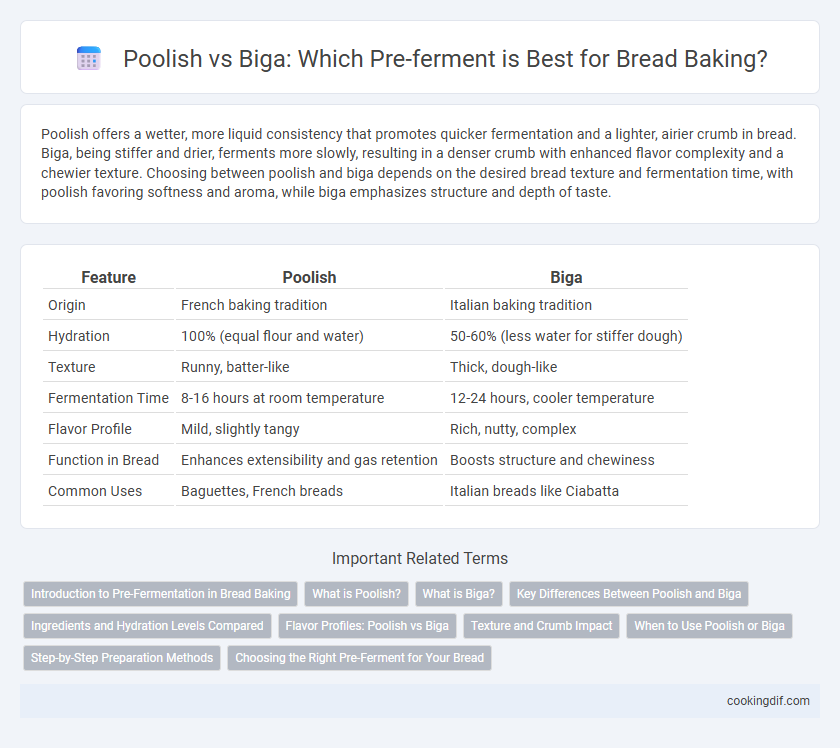Poolish offers a wetter, more liquid consistency that promotes quicker fermentation and a lighter, airier crumb in bread. Biga, being stiffer and drier, ferments more slowly, resulting in a denser crumb with enhanced flavor complexity and a chewier texture. Choosing between poolish and biga depends on the desired bread texture and fermentation time, with poolish favoring softness and aroma, while biga emphasizes structure and depth of taste.
Table of Comparison
| Feature | Poolish | Biga |
|---|---|---|
| Origin | French baking tradition | Italian baking tradition |
| Hydration | 100% (equal flour and water) | 50-60% (less water for stiffer dough) |
| Texture | Runny, batter-like | Thick, dough-like |
| Fermentation Time | 8-16 hours at room temperature | 12-24 hours, cooler temperature |
| Flavor Profile | Mild, slightly tangy | Rich, nutty, complex |
| Function in Bread | Enhances extensibility and gas retention | Boosts structure and chewiness |
| Common Uses | Baguettes, French breads | Italian breads like Ciabatta |
Introduction to Pre-Fermentation in Bread Baking
Pre-fermentation enhances bread flavor, texture, and shelf life by allowing yeast and bacteria to develop before mixing the final dough. Poolish, a wet sponge with equal parts water and flour, creates a light, airy crumb and subtle tang, making it ideal for rustic French breads. Biga, a stiffer dough with lower hydration, produces a firmer texture and a more complex, slightly nutty flavor commonly found in Italian bread varieties.
What is Poolish?
Poolish is a French-style pre-ferment consisting of equal parts flour and water by weight, combined with a small amount of yeast to develop flavor and improve dough extensibility. This wet, sponge-like mixture typically ferments for 12 to 16 hours at room temperature, resulting in a bubbly texture and a slightly tangy aroma that enhances the final bread's taste. Bakers favor poolish for its ability to create open crumb structure and a thin, crisp crust in artisanal breads.
What is Biga?
Biga is a traditional Italian pre-ferment made from flour, water, and a small amount of yeast, known for its stiff, dough-like consistency that enhances bread flavor and structure. It ferments longer than poolish, typically 12-16 hours, allowing yeast to develop complex aromas and improve gluten strength for a chewier crumb. Bakers prefer biga for rustic breads like ciabatta and focaccia due to its ability to create a more open crumb and nutty taste.
Key Differences Between Poolish and Biga
Poolish is a French pre-fermentation with a liquid consistency and equal parts flour and water, producing a mild, slightly tangy flavor. Biga is an Italian pre-fermentation with a stiff, dough-like texture and lower hydration, resulting in a nutty, complex taste and a chewier crumb. The choice of poolish enhances extensibility and open crumb, while biga contributes to dough strength and a denser structure.
Ingredients and Hydration Levels Compared
Poolish typically consists of equal parts flour and water, resulting in a high hydration level of around 100%, promoting a wetter and more batter-like pre-ferment. Biga, on the other hand, features lower hydration levels, usually between 50-60%, creating a stiffer dough that contributes to a firmer texture and more complex flavor in the final bread. The choice between poolish and biga largely depends on the desired crumb structure, fermentation time, and taste profile in artisanal bread-making.
Flavor Profiles: Poolish vs Biga
Poolish imparts a mild, slightly tangy flavor with a tender crumb due to its higher hydration and shorter fermentation time, enhancing the bread's subtle sweetness. Biga produces a more complex, nutty, and robust flavor profile, resulting from its stiffer dough and longer fermentation, which intensifies the bread's aroma and chewiness. Choosing between Poolish and Biga directly influences the bread's taste depth and texture, catering to different artisanal baking preferences.
Texture and Crumb Impact
Poolish pre-fermentation produces a bread with an open crumb structure and a slightly moist, tender texture due to its high hydration level, promoting extensibility in the dough. Biga, being a stiffer pre-ferment, results in a denser crumb with a chewy texture and more pronounced fermentation flavor complexities. The choice between poolish and biga directly influences the final bread's crumb irregularity and crust crispness, essential for artisanal bread quality.
When to Use Poolish or Biga
Poolish is ideal for recipes requiring a lighter crumb and slightly tangy flavor, typically used in French and Polish-style breads. Biga, with its drier consistency, is preferred for Italian breads like ciabatta, offering a denser texture and more complex aroma. Choose poolish when aiming for extended fermentation without sacrificing dough extensibility, and biga when needing more structure and firm crumb development.
Step-by-Step Preparation Methods
Poolish involves mixing equal parts flour and water with a small amount of yeast, then fermenting at room temperature for 12-16 hours until bubbly and aromatic. Biga, an Italian pre-ferment, uses a stiffer dough with less hydration, combining flour, water, and yeast, then fermenting for 12-24 hours in a cooler environment to develop a nutty flavor. Both methods require precise timing and temperature control to optimize gluten development and flavor complexity before incorporating into the final dough.
Choosing the Right Pre-Ferment for Your Bread
Selecting the right pre-ferment between poolish and biga depends on the desired bread texture and flavor profile. Poolish, a wet and pourable pre-ferment with equal parts water and flour, imparts a lighter crumb and mild tang, ideal for baguettes and soft rolls. Biga is stiffer with less hydration, providing a nuttier flavor and chewier texture, perfect for artisan-style breads and rustic loaves.
Poolish vs biga for pre-fermentation Infographic

 cookingdif.com
cookingdif.com